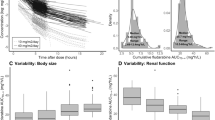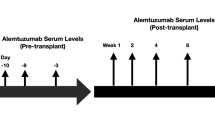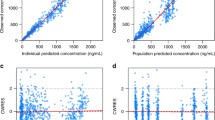Abstract
Purpose
Quantitative relationships between 9-β-d-arabinofuranosyl-2-fluoroadenine (F-ara-A) concentrations and lymphosuppression have not been reported, but would be useful for regimen design. A population pharmacokinetic/pharmacodynamic model was constructed in this study using data from 41 hematopoietic cell transplant (HCT) recipients conditioned with busulfan in combination with fludarabine (total dose 120 mg/m2, Protocol 1519) or with fludarabine (total dose 250 mg/m2) with rabbit antithymocyte globulin (rATG, Protocol 2041).
Methods
Individual pharmacokinetic parameters were fixed to post hoc Bayesian estimates, and circulating absolute lymphocyte counts (ALC) were obtained during the 3 weeks prior to graft infusion. A semi-physiological cell-kill model with three lymphocyte transit compartments was applied and aptly characterized the time course of suppression of circulating ALC by fludarabine administration. Drug- and system-specific parameters were estimated using a maximum likelihood expectation maximization algorithm, and the final model was qualified using an internal visual predictive check.
Results
The final model successfully characterized the time course and variability in ALC. Pharmacodynamic parameters exhibited considerable between subject variability (38.9–211 %). The HCT protocol was the only covariate associated with the pharmacodynamic parameters, specifically the lymphocyte kill rate, the transit rate between lymphocyte compartments, and the baseline ALC.
Conclusions
This model can be used to simulate the degree of lymphosuppression for design of future fludarabine-based conditioning regimens.




Similar content being viewed by others
References
Deeg HJ, Maris MB, Scott BL, Warren EH (2006) Optimization of allogeneic transplant conditioning: not the time for dogma. Leukemia 20(10):1701–1705
Bredeson CN, Zhang MJ, Agovi MA, Bacigalupo A, Bahlis NJ, Ballen K, Brown C, Chaudhry MA, Horowitz MM, Kurian S, Quinlan D, Muehlenbien CE, Russell JA, Savoie L, Rizzo JD, Stewart DA (2008) Outcomes following HSCT using fludarabine, busulfan, and thymoglobulin: a matched comparison to allogeneic transplants conditioned with busulfan and cyclophosphamide. Biol Blood Marrow Transplant 14(9):993–1003. doi:10.1016/j.bbmt.2008.06.009
Andersson BS, de Lima M, Thall PF, Wang X, Couriel D, Korbling M, Roberson S, Giralt S, Pierre B, Russell JA, Shpall EJ, Jones RB, Champlin RE (2008) Once daily i.v. busulfan and fludarabine (i.v. Bu-Flu) compares favorably with i.v. busulfan and cyclophosphamide (i.v. BuCy2) as pretransplant conditioning therapy in AML/MDS. Biol Blood Marrow Transplant 14(6):672–684
Lee JH, Joo YD, Kim H, Ryoo HM, Kim MK, Lee GW, Lee JH, Lee WS, Park JH, Bae SH, Hyun MS, Kim DY, Kim SD, Min YJ, Lee KH (2013) Randomized trial of myeloablative conditioning regimens: busulfan plus cyclophosphamide versus busulfan plus fludarabine. J Clin Oncol 31(6):701–709. doi:10.1200/JCO.2011.40.2362
Danhauser L, Plunkett W, Liliemark J, Gandhi V, Iacoboni S, Keating M (1987) Comparison between the plasma and intracellular pharmacology of 1-beta-D-arabinofuranosylcytosine and 9-beta-D-arabinofuranosyl-2-fluoroadenine 5′-monophosphate in patients with relapsed leukemia. Leukemia 1(9):638–643
Gandhi V, Plunkett W (2002) Cellular and clinical pharmacology of fludarabine. Clin Pharmacokinet 41(2):93–103
Robak T, Lech-Maranda E, Korycka A, Robak E (2006) Purine nucleoside analogs as immunosuppressive and antineoplastic agents: mechanism of action and clinical activity. Curr Med Chem 13(26):3165–3189
Kalhorn TF, Ren AG, Slattery JT, McCune JS, Wang J (2005) A highly sensitive high-performance liquid chromatography-mass spectrometry method for quantification of fludarabine triphosphate in leukemic cells. J Chromatogr B Analyt Technol Biomed Life Sci 820(2):243–250
Bornhauser M, Storer B, Slattery JT, Appelbaum FR, Deeg HJ, Hansen J, Martin PJ, McDonald GB, Nichols WG, Radich J, Woolfrey A, Jenke A, Schleyer E, Thiede C, Ehninger G, Anasetti C (2003) Conditioning with fludarabine and targeted busulfan for transplantation of allogeneic hematopoietic stem cells. Blood 102(3):820–826
Long-Boyle JR, Green KG, Brunstein CG, Cao Q, Rogosheske J, Weisdorf DJ, Miller JS, Wagner JE, McGlave PB, Jacobson PA (2011) High fludarabine exposure and relationship with treatment-related mortality after nonmyeloablative hematopoietic cell transplantation. Bone Marrow Transplant 46(1):20–26. doi:10.1038/bmt.2010.53
Salinger DH, Blough DK, Vicini P, Anasetti C, O’Donnell PV, Sandmaier BM, McCune JS (2009) A limited sampling schedule to estimate individual pharmacokinetic parameters of fludarabine in hematopoietic cell transplant patients. Clin Cancer Res 15(16):5280–5287. doi:10.1158/1078-0432.CCR-09-0427
Woodahl EL, Wang J, Heimfeld S, Sandmaier BM, O’Donnell PV, Phillips B, Risler L, Blough DK, McCune JS (2009) A novel phenotypic method to determine fludarabine triphosphate accumulation in T-lymphocytes from hematopoietic cell transplantation patients. Cancer Chemother Pharmacol 63(3):391–401 Epub 2008 Apr 2009
McCune JS, Woodahl EL, Furlong T, Storer B, Wang J, Heimfeld S, Deeg HJ, O’Donnell PV (2012) A pilot pharmacologic biomarker study of busulfan and fludarabine in hematopoietic cell transplant recipients. Cancer Chemother Pharmacol 69(1):263–272. doi:10.1007/s00280-011-1736-3
McCune JS, Holmberg LA (2009) Busulfan in hematopoietic stem cell transplant setting. Expert Opin Drug Metab Toxicol 5(8):957–969. doi:10.1517/17425250903107764
Holford NHG (2005) The visual predictive check—superiority to standard diagnostic (Rorschach) plots. Abstracts of the annual meeting of the population approach group in Europe (PAGE) 14:Abstr 738. http://www.page-meeting.org/?abstract=738
Friberg LE, Freijs A, Sandstrom M, Karlsson MO (2000) Semiphysiological model for the time course of leukocytes after varying schedules of 5-fluorouracil in rats. J Pharmacol Exp Ther 295(2):734–740
Cheson BD (1995) Infectious and immunosuppressive complications of purine analog therapy. J Clin Oncol 13(9):2431–2448
Boumpas DT, Tassiulas IO, Fleisher TA, Vaughan E, Piscitelli S, Kim Y, Pucino F, Balow JE, Austin HA (1999) A pilot study of low-dose fludarabine in membranous nephropathy refractory to therapy. Clin Nephrol 52(2):67–75
Sandoval A, Consoli U, Plunkett W (1996) Fludarabine-mediated inhibition of nucleotide excision repair induces apoptosis in quiescent human lymphocytes. Clin Cancer Res 2(10):1731–1741
Plunkett W, Gandhi V, Huang P, Robertson LE, Yang LY, Gregoire V, Estey E, Keating MJ (1993) Fludarabine: pharmacokinetics, mechanisms of action, and rationales for combination therapies. Semin Oncol 20(5 Suppl 7):2–12
Gamberale R, Galmarini CM, Fernandez-Calotti P, Jordheim L, Sanchez-Avalos J, Dumontet C, Geffner J, Giordano M (2003) In vitro susceptibility of CD4+ and CD8+ T cell subsets to fludarabine. Biochem Pharmacol 66(11):2185–2191
Woodahl EL, Wang J, Heimfeld S, Sandmaier BM, McCune JS (2009) Intracellular disposition of fludarabine triphosphate in human natural killer cells. Cancer Chemother Pharmacol 63(5):959–964
Schmitt A, Gladieff L, Laffont CM, Evrard A, Boyer JC, Lansiaux A, Bobin-Dubigeon C, Etienne-Grimaldi MC, Boisdron-Celle M, Mousseau M, Pinguet F, Floquet A, Billaud EM, Durdux C, Le Guellec C, Mazieres J, Lafont T, Ollivier F, Concordet D, Chatelut E (2010) Factors for hematopoietic toxicity of carboplatin: refining the targeting of carboplatin systemic exposure. J Clin Oncol 28(30):4568–4574. doi:10.1200/JCO.2010.29.3597
Wallin JE, Friberg LE, Karlsson MO (2009) A tool for neutrophil guided dose adaptation in chemotherapy. Comput Methods Programs Biomed 93(3):283–291
Bleyzac N, Souillet G, Magron P, Janoly A, Martin P, Bertrand Y, Galambrun C, Dai Q, Maire P, Jelliffe RW, Aulagner G (2001) Improved clinical outcome of paediatric bone marrow recipients using a test dose and Bayesian pharmacokinetic individualization of busulfan dosage regimens. Bone Marrow Transplant 28(8):743–751. doi:10.1038/sj.bmt.1703207
McCune JS, Batchelder A, Guthrie KA, Witherspoon R, Appelbaum FR, Phillips B, Vicini P, Salinger DH, McDonald GB (2009) Personalized dosing of cyclophosphamide in the total body irradiation-cyclophosphamide conditioning regimen: a phase II trial in patients with hematologic malignancy. Clin Pharmacol Ther 85(6):615–622
Kolb HJ, Storb R, Weiden PL, Ochs HD, Kolb H, Graham TC, Floersheim GL, Thomas ED (1974) Immunologic, toxicologic and marrow transplantation studies in dogs given dimethyl myleran. Biomedicine 20(5):341–351
Santos GW, Tutschka PJ (1974) Marrow transplantation in the busulfan-treated rat: preclinical model of aplastic anemia. J Natl Cancer Inst 53(6):1781–1785
Theurich S, Fischmann H, Shimabukuro-Vornhagen A, Chemnitz JM, Holtick U, Scheid C, Skoetz N, von Bergwelt-Baildon M (2012) Polyclonal anti-thymocyte globulins for the prophylaxis of graft-versus-host disease after allogeneic stem cell or bone marrow transplantation in adults. Cochrane Database Syst Rev 9:CD009159. doi:10.1002/14651858.CD009159.pub2
Ballen KK (2014) ATG for cord blood transplant: yes or no? Blood 123(1):7–8. doi:10.1182/blood-2013-11-537001
Waller EK, Langston AA, Lonial S, Cherry J, Somani J, Allen AJ, Rosenthal H, Redei I (2003) Pharmacokinetics and pharmacodynamics of anti-thymocyte globulin in recipients of partially HLA-matched blood hematopoietic progenitor cell transplantation. Biol Blood Marrow Transplant 9(7):460–471
Seymour L, Eisenhauer E (2001) A review of dose-limiting events in phase I trials: antimetabolites show unpredictable relationships between dose and toxicity. Cancer Chemother Pharmacol 47(1):2–10
Le Blanc K, Barrett AJ, Schaffer M, Hagglund H, Ljungman P, Ringden O, Remberger M (2009) Lymphocyte recovery is a major determinant of outcome after matched unrelated myeloablative transplantation for myelogenous malignancies. Biol Blood Marrow Transplant 15(9):1108–1115
Powles R, Singhal S, Treleaven J, Kulkarni S, Horton C, Mehta J (1998) Identification of patients who may benefit from prophylactic immunotherapy after bone marrow transplantation for acute myeloid leukemia on the basis of lymphocyte recovery early after transplantation. Blood 91(9):3481–3486
Kim DH, Kim JG, Sohn SK, Sung WJ, Suh JS, Lee KS, Lee KB (2004) Clinical impact of early absolute lymphocyte count after allogeneic stem cell transplantation. Br J Haematol 125(2):217–224
Kumar S, Chen MG, Gastineau DA, Gertz MA, Inwards DJ, Lacy MQ, Tefferi A, Litzow MR (2001) Effect of slow lymphocyte recovery and type of graft-versus-host disease prophylaxis on relapse after allogeneic bone marrow transplantation for acute myelogenous leukemia. Bone Marrow Transplant 28(10):951–956
Lee KH, Choi SJ, Lee JH, Lee JS, Kim WK, Lee KB, Sohn SK, Kim JG, Kim DH, Seol M, Lee YS, Lee JH (2005) Prognostic factors identifiable at the time of onset of acute graft-versus-host disease after allogeneic hematopoietic cell transplantation. Haematologica 90(7):939–948
Chakrabarti S, Brown J, Guttridge M, Pamphilon DH, Lankester A, Marks DI (2003) Early lymphocyte recovery is an important determinant of outcome following allogeneic transplantation with CD34 + selected graft and limited T-cell addback. Bone Marrow Transplant 32(1):23–30
Mueller AMS, Florek M, Hadeiba H, Shizuru JA (2010) Interactions between donor CD4 cells and residual host cells after nonmyeloablative hematopoietic stem cell transplantation suppress hematopoiesis and lead to graft rejection. In: 52nd Annual American Society of Hematology Meeting, Orlando, FL, 2010. p Abstract #75
Salit RB, Fowler DH, Dean RM, Pavletic SZ, Hakim FT, Steinberg SM, Hardy NT, Sportes C, Gress RE, Bishop MR (2013) Host lymphocyte depletion as a strategy to facilitate early full donor chimerism after reduced-intensity allogeneic stem cell transplantation. Biol Blood Marrow Transplant 19(10):1509–1513. doi:10.1016/j.bbmt.2013.08.001
Petrus MJ, Williams JF, Eckhaus MA, Gress RE, Fowler DH (2000) An immunoablative regimen of fludarabine and cyclophosphamide prevents fully MHC-mismatched murine marrow graft rejection independent of GVHD. Biol Blood Marrow Transplant 6(2A):182–189
Hassan SB, Haglund C, Aleskog A, Larsson R, Lindhagen E (2007) Primary lymphocytes as predictors for species differences in cytotoxic drug sensitivity. Toxicol In Vitro 21(6):1174–1181. doi:10.1016/j.tiv.2007.03.009
Acknowledgments
Supported by grants from the National Institutes of Health: NHLBI (HL91744, HL36444), NCI (CA15704 (core), 18029, 78902), NIBIB (EB001975), and NIGMS (GM57980).
Author information
Authors and Affiliations
Corresponding author
Rights and permissions
About this article
Cite this article
McCune, J.S., Vicini, P., Salinger, D.H. et al. Population pharmacokinetic/dynamic model of lymphosuppression after fludarabine administration. Cancer Chemother Pharmacol 75, 67–75 (2015). https://doi.org/10.1007/s00280-014-2618-2
Received:
Accepted:
Published:
Issue Date:
DOI: https://doi.org/10.1007/s00280-014-2618-2




